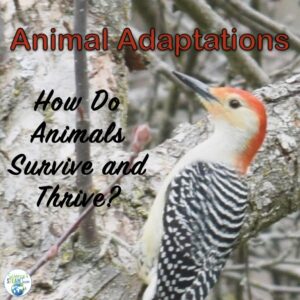What are animal adaptations?
Animal adaptations are changes that animals make in order to survive. These changes help animals to meet their basic needs for air, food, water, shelter, and space to live. So, just how do animals adapt to their environment?
Behavioral Adaptations
Animals make behavioral adaptations. Behavioral adaptations are the way an animal acts. There are two types of behavioral adaptations.
Inherited Behaviors
Inherited, also known as instinctual, adaptations don’t have to be learned. They come naturally. Examples of these are:
- Migration
- Hibernation
- Being nocturnal
- Defensive behaviors
- Mating or courtship behaviors
Learned Behaviors
Learned behaviors are a result of experience. Young animals learn things by observing their parents or other animals in their species. Some of those behaviors include:
- How to find food
- Making a shelter
- How to communicate
- How to get along in a group
- Looking out for predators
Physical Adaptations
Animals make physical adaptations to help them live in their environment. Physical, or structural, adaptations are physical features that change. Animals that live in cool environments need different physical adaptations than animals that live in a warm habitat. These features can include:
Body Parts
- Types of feet
- Kinds of claws
- Types of mouths and/or beaks
- Type of body covering
Color and Pattern
- Camouflage
- Mimicry – an adaptation that helps a harmless animal look or sound like a harmful animal in order to protect itself
Physiological Adaptations
Unlike physical adaptations, which can be seen, physiological adaptations occur internally. Examples of how animals adapt to their environment physiologically are:
- Regulating body temperature
- Releasing poisons and other substances
Examples of Animal Adaptations
Orangutans have adapted to living in the rainforest. These mammals use their flexible legs and arms to move among the trees. Orangutans’ arms are longer than their legs. Their arms are stronger than their legs so that they can hold the weight of their bodies. They are able to use their fingers as humans do. They use these to grasp things like food and tools. Orangutans have dark brown eyes to protect them from the sun.
Woodpeckers have strong bills for drilling holes in trees. They have a spongy skull that absorbs the impact of the pecking. Woodpeckers use their long, sticky tongue to get insects out of the holes so they can eat them. Their stiff tail feathers help them to balance.
How Do Animals Adapt to Their Environment: Teaching Ideas
- First, read about how different animals adapt to their habitats. Animals that live in the desert need to make different adaptations than animals that live in the arctic or in the ocean. Go to the library and check out books on various habitats and the animals that live in them.
I am writing this post in celebration of selling hundreds of award-winning books to school districts this past summer. This book is best for elementary grades. One page gives a description of the habitat, and the next few pages show animals that live in that habitat and the adaptations they make to live there successfully. This continues for multiple habitats.
Author, Sandra Markle has a wonderful series of books for children called What if You Had… ( an animal tongue, animal hair, etc.). Students always get a good giggle out of these!
We also have reading passages in our TpT shop about animal adaptations. Students read these while filling out a graphic organizer to keep them on task. We have a passage about mimicry too.
- Ask students to design a new animal. With young students, I find it easiest to show them lots of pictures of different animals. Then they take one physical feature, change it and tell how this will help the animal. For older students, we have designed task cards like this. Students use this information and draw this animal, label its adaptations, and name the animal.
We created a set of posters with pictures that show all of the adaptations listed in this post.
So, now you know how animals adapt to their environment. Teaching this engaging concept should be a breeze for you!
And remember, it’s all science!
Sarah













One Comment